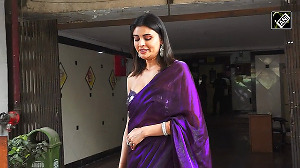There are over 83,000 Indians studying in the US.
Over 14 per cent of all student visa applications to the US come from India.
From 2001 to 2006, over 1.81 lakh visas to the US have been issued in India alone.
Going the United States of America to study or work is a dream that is cherished by many among us. Dream college, dream office, dream city -- we've got it all figured out and over the course of our school, college and work years we put in our best efforts to ensure we have a record that will make that dream possible. And for many, as the figures suggest, this dream does become a reality. However, even the most valiant effort is often brought to naught with the denial of the all-important, often elusive VISA.
Considering the kind of effort, expense, apprehension and ambition that goes with the visa application and ensuing interview, the Indo-American Society organised an event on December 19 in Mumbai, in an attempt to inform, simplify and clarify procedures for student and temporary work visas.
Angela Kerwin, a Foreign Service Officer currently serving as the non-immigrant visa chief at the US Consulate General in Mumbai, addressed the audience explaining the exact process a visa application goes through before it is granted or denied. In what was an informative presentation, she also addressed certain FAQs regarding visa rejections and re-application procedures. Here's a look at what was discussed:
Student visas
Kerwin started off with the basics, the three types of student visas: F, M, J.
~ F visas: These are the most popular of the three, and apply to students hoping to pursue graduate (Bachelors), post-graduate (Masters), associates and doctoral courses, among others. Visas are issued for courses with the duration of 2-4 years.
~ M visas: These are course specific and apply to vocational courses such as culinary or aviation programmes. These are usually for less than a year.
~ J visas: These are generally for exchange visitors and cover a wide gamut of courses, such as specialised training camps, internships, post-doctoral research projects etc.
Application process
Taking the audience through the application process step by step, Kerwin went through the requirements and paperwork required by the US consulate to approve any student visa application.
Step 1: Do your homework
What course you want to pursue? What you want from your course and education? Why you want to study in the US? Why does a US education make sense for you? What do you plan to do after your course? Why do you want to study in a particular school/city/area?
You should have a clear idea of what your education and career plan is before you begin the application process. This is the most important part.
"Think about whether you will be able to adjust to a college with 2,000 students on campus or with 50,000; or an urban area with a bustling population as compared to a quieter rural zone," urges Kerwin.
Step 2: College applications
Before applying, make sure you don't put all your eggs in one basket. Narrow in on 2-3 colleges that offer the course you want and apply to each of them. This back-up plan will serve you in good stead if your first choice doesn't come through. Each college will have its own requirements -- paperwork, academic records, essays etc -- that should be available on their web sites. Scholarships and tuition fees will also need to be checked and seen to.
Once you have been accepted, the college will send you a form -- the I-20 -- with the details of the name of the school, course, fees, etc, following which the visa process begins.
Step 3: Visa application
Once you receive the I-20, you can begin the process of applying for your student visa. Students will need to register with VFS at www.vfs-usa.co.in by following the instructions provided on the web site. A payment of $100 (this fee will be increased on January 1, 2008) will need to be paid as a visa application fee.
Once registered, the applicant will receive an appointment for the visa interview within 2 weeks of application.
Applicants will need to supply a copy of the bio page of their passport, appointment form and the I-20 form to VFS, five days before the interview. "This is not to make things more difficult for applicants," assures Kerwin. "We have certain space constraints and this is just to facilitate ease of handling. NO decision is made at this point."
Step 4: At the interview
All your effort thus far boils down to the visa interview. Your homework is what will be tested by the visa officer, and you should be prepared.
"Relax, be calm," advises Kerwin. The visa officer just needs to see that you have thought your decision through.
Interview dos & don'ts
- Carry your passport, application letter and I-20 form
- Carry the most relevant academic records. "We are not going to check your kindergarten grades," she jokes.
- Carry as little as possible to the interview. Do not carry electronics with you -- no cell phones, cameras etc.
The new biometric system has been introduced for US travel as well (UK and France have also introduced this system), where applicants are fingerprinted (all 10 fingers) and photographed. Once this has been completed, the interview will follow within an hour or so.
"Remember to listen," says Kerwin. "Do not anticipate or guess what the adjudicating visa officer is going to ask or says things you think the visa officer expects to hear. Speak honestly after listening carefully to the question asked."
When asked about the college you've been accepted into, "DO NOT recite everything you read on the school's website!" urges Kerwin. "That is not what we want to hear."
Pointers
- There is no pre-determined amount you need to show as liquid assets. The fees are already mentioned on the I-20, all you need to know is how you will be paying the fees -- whether your parents will be sponsoring you, or your brother or uncle or all three. You can have more than one sponsor, and they can be in the US as a citizen or valid visa holder. Bank loans are also accepted as means of payment.
- A previous visa rejection does not prevent you from applying again for the same or a different visa category. It also does not affect a subsequent application unless the prior application was rejected due to an ineligibility such as fraudulent claims of qualifications, misrepresentation of your details, fake documents etc.
- Two subsequent rejections require you to wait a year before you can re-apply.
- You may hold a tourist or any other visa at the time of applying for a student visa.
- If you hope to work in the US after you graduate, there is one year built into the F visa to allow you this. The officer is looking for you to convince him/her of your return after training post graduation.
Following the interview, the documents -- passport, application form etc -- will be sent by courier to the applicant within 1 or 2 days.
"The UK and Australia are good, but we're better and we want you," says Kerwin with a laugh. "Just do you homework!"





